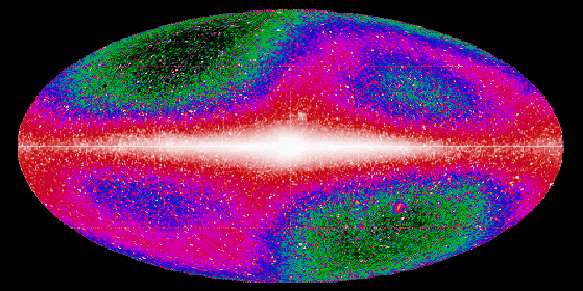Credit & Copyright: The COBE Project,
NASA
Explanation:
What if you could see
infrared light?
Because this light is less
absorbed by dust
than visible light, you could
peer into the center of our Milky Way Galaxy. The stars there are
normally hidden from direct view by
the interstellar dust clouds which
line the Galactic plane.
Above is a false color image of the entire sky made by
the DIRBE instrument onboard
NASA's COBE Satellite using
infrared light with a wavelength of 3.5 microns
- about 7 times longer than the wavelength of visible light.
The galactic plane runs horizontally along the middle of the image.
At this wavelength, the
cool stars in our galaxy shine brightly and can be seen to define the
plane of the Milky Way and the central bulge.
Interplanetary dust,
which tends to lie along the plane of our
own solar system, scatters sunlight and emits radiation at these
wavelengths too.
The faint glow it produces results in the
"S" shape apparent in this infrared all-sky view.
1999 2000 2001 2002 2003 2004 2005 2006 2007 2008 2009 2010 2011 2012 2013 2014 2015 2016 2017 2018 2019 2020 2021 2022 2023 2024 2025 |
Январь Февраль Март Апрель Май Июнь Июль Август Сентябрь Октябрь Ноябрь Декабрь |
NASA Web Site Statements, Warnings, and Disclaimers
NASA Official: Jay Norris. Specific rights apply.
A service of: LHEA at NASA / GSFC
& Michigan Tech. U.
|
Публикации с ключевыми словами:
инфракрасное излучение - Межзвездная пыль - Межпланетная пыль
Публикации со словами: инфракрасное излучение - Межзвездная пыль - Межпланетная пыль | |
См. также:
Все публикации на ту же тему >> | |
